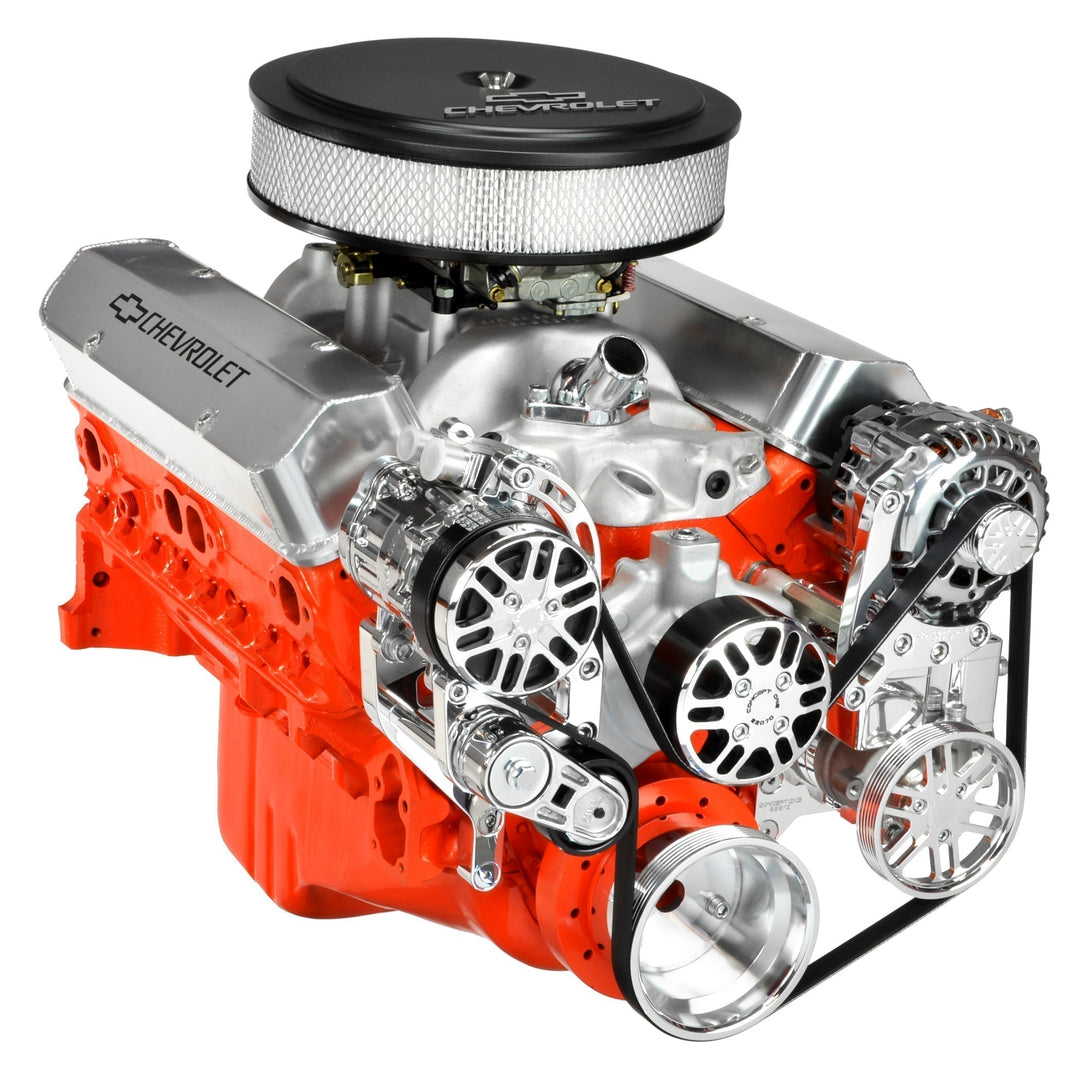
Serpentine Belt Conversion for Small Block Chevy
Posted on

Serpentine conversion is a smart upgrade to enhance the reliability and performance of your Small Block Chevy engine. The conversion process remains the same whether you are converting a 350, 400, or any Gen-1 Small Block Chevy. Let’s compare an old-school V-belt setup with a modern serpentine accessory drive. The differences and benefits go far beyond the belt types, including bracket design and modern drive components.
Modern Accessory Drive Components
Drive components like alternators, power steering pumps, and AC compressors have advanced significantly since the ‘60s and ‘70s muscle car era. Unless you’re aiming for a concours-correct restoration, upgrading to a modern R134a AC compressor with a serpentine pulley is a smart choice. For instance, traditional AC compressors and their brackets can easily weigh 40 pounds. In contrast, a modern SD-7 compressor weighs only 11-12 pounds, including brackets. The SD-7 provides much better cooling capacity and is extremely compact, allowing it to be mounted directly in front of a cylinder head rather than hanging off the side of the engine.

Alternators follow the same principle of being "smaller, lighter, and more efficient." Older models, such as the 10DN, 10SI, and 12SI, have bulky cases and limited amperage. Typically, these older alternators produce only 55 amps and struggle to handle high RPMs over extended periods. In contrast, the mid-80s CS130 represented a significant advancement in alternator design, featuring improved RPM capability and convenient 140 amp ratings. Concept One still offers CS130 alternators with specific pulley kits, including a stylish billet external fan for enhanced cooling.
Alternator design has evolved as the world incorporates more electronics into vehicles. Nowadays, a high amp alternator is necessary to meet the demand. The CS130D alternator meets this need with its high amperage, compact case, internal fan, and high rpm capability. Your hot rod may feature a combination of EFI, electric fans, car audio, electric fuel pumps, transmission control, air suspension, air conditioning, power windows, and more. Most Concept One serpentine conversion kits come with Powermaster CS130D alternators rated at 95 amps at idle and 120 amps at speed, with an optional upgrade to 100 amps/165 amps. Additional alternator options are available.

Serpentine Belt vs V-Belts: At Least Three X More Grip
We are here to explain that serpentine belts are superior to V-belts. A 6-rib serpentine belt, by design, provides at least three times more grip than a V-belt. This is due to the fact that a V-belt contacts its corresponding pulley with two surfaces—the sides of the “V”. In contrast, a 6-rib serpentine belt utilizes the sides of each rib along with the root surface situated between each rib. The root surface is the flat area at the base of the belt, which makes contact with the peak of each rib on the corresponding pulley.
The backside of the belt offers increased surface contact as it engages any smooth pulleys in the system—usually a water pump. Ultimately, the serpentine design enhances engagement while requiring less belt wrap. Thus, you achieve greater engagement with less parasitic loss.
Combined with a spring-loaded tensioner and idler pulley, a serpentine belt maintains adjustment 3 times longer than a V-belt system. Stamped steel brackets cannot compete with fixed billet brackets and a spring-loaded tensioner. A typical serpentine belt is rated to last between 60,000 and 100,000 miles. If you are concerned about running a single serpentine belt, buy a spare belt and keep it in the trunk next to your spare tire.

Classic V-Belt System Design Issues
As you can see, the challenges facing classic V-belt accessory drives extends far beyond the belt itself. If you are hanging on to that old system, then you probably have heavy steel brackets in addition to outdated accessories. Check out the second gen Camaro system in the image above. "A." points to an extremely heavy AC compressor that consumes all of the space on the left side of the engine. Massive cast and stamped steel brackets are required to hang the compressor out this far. The upper alternator bracket "B" is one of the better designs of the day. It would routinely cause adjustment to loosen over time. A serpentine belt is better than a V-belt. The same is true for the modern accessories and brackets.

Serpentine Conversion Tips
Here are some tips for choosing a 350 serpentine conversion kit. Buy a complete serpentine conversion kit that includes all brackets, accessory drive components, and hardware. This is the only way to ensure all accessories line up for proper belt alignment. Consider your Alternator amp requirements before purchasing a serpentine conversion system. If you have EFI and other electronics, buy a system with a CS130D alternator. Beware of systems with a single plate that bolts to the water pump. Typically, these designs only support accessories at the front. The plate can flex, affecting belt alignment and even leading to stress cracks in the plate itself. At Concept One, we often have people asking to buy our brackets because of a cracked accessory mounting plate. Concept One does not sell its brackets separately. Buy a system like Concept One and other brands with individual brackets that fully support each accessory drive component.
Links:
Small Block Chevy Serpentine Conversion Kits
Gates Automotive Micro-V Belts



